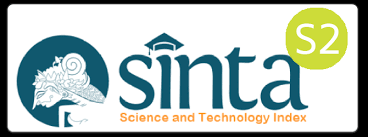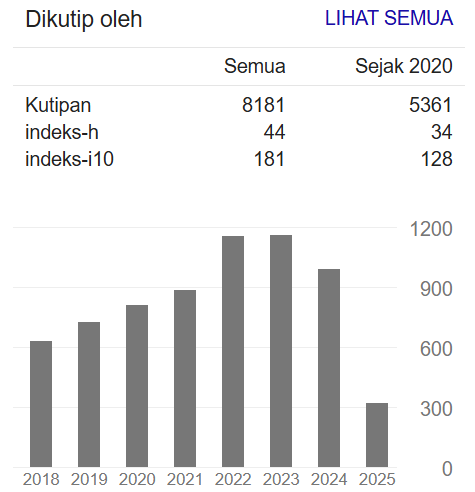PENGARUH JALAN KAKI DAN RELAKSASI NAPAS DALAM (JAKARENA) TERHADAP KADAR GULA DARAH KELOMPOK PREDIABETES
DOI:
https://doi.org/10.34011/jmp2k.v34i4.2633Keywords:
blood glucose, JAKARENA, prediabetesAbstract
The prevalence of prediabetes (preDM) in Indonesia is increasing, posing a significant risk for developing Diabetes Mellitus (DM). The American Diabetes Association (ADA) predicts that approximately 70% of individuals with preDM will progress to diabetes. Globally, the number of people with DM is projected to reach 693 million by 2045. In 2019, Bandung City reported 45,430 individuals with DM. Prediabetes management necessitates a comprehensive approach, including lifestyle modifications such as increased physical activity, exercise, and dietary control. This study aimed to investigate the effect of a combined walking and deep breathing relaxation exercise program (JAKARENA) on blood glucose levels in individuals with preDM. This analytical study employed a quasi-experimental design with a Non-equivalent Group Pre-test-Post-test design. The population comprised adults with preDM, with 46 participants selected through purposive sampling and divided into intervention and control groups. Data analysis utilized the Independent T-test. Results demonstrated that the mean baseline blood glucose level in the control group (108.39 mg/dl) was lower than that of the intervention group (111.00 mg/dl). Post-intervention, the control group exhibited a slight increase in blood glucose levels (109.65 mg/dl), whereas the intervention group experienced a significant decrease (102.75 mg/dl). The statistical analysis yielded a p-value of 0.001, indicating a statistically significant effect of JAKARENA on reducing blood glucose levels in individuals with preDM. Conclusion: JAKARENA exercise demonstrates the potential to effectively lower blood glucose levels in individuals with preDM and can be recommended as a valuable community-based intervention to mitigate the progression of preDM to DM.
References
Persadia & Perkeni, Pedoman Pengolaan dan Pencegahan Prediabetes di Indonesia 2019. 2020.
N. Shylma and T. Jimmy, “Prediabetes , Saat Gula Darah Tinggi dan Berisiko Besar Kena Diabetes,” pp. 1–13, 2021, [Online]. Available: https://hellosehat.com/diabetes/tipe-2/prediabetes/
C. C. Adhania, G. Wiwaha, and P. I. Fianza, “Prevalensi Penyakit Tidak Menular pada Fasilitas Kesehatan Tingkat Pertama di Kota Bandung Tahun 2013-2015,” J. Sist. Kesehat., vol. 3, no. 4, 2018, doi: 10.24198/jsk.v3i4.18499.
Dinas Kesehatan Kota Bandung, “Profil Kesehatan Kota Bandung Tahun 2019,”, 2019, [Online]. Available: https://dinkes.bandung.go.id/
Kemenkes RI, “Pedoman Pengelolaan Prediabetes Untuk Tenaga Kesehatan Di fasilitas pelayanan kesehatan tingkat pertama (fktp),” p. 86, 2021.
N. Bansal, “Prediabetes diagnosis and treatment: A review,” World J. Diabetes, vol. 6, no. 2, p. 296, 2015, doi: 10.4239/wjd.v6.i2.296.
J. Darmawan, “Kontroversi Prediabetes - Alomedika,” Alomedika Khusus Untuk Dr., no. Kontroversi Prediabetes, pp. 1–7, 2019, [Online]. Available: https://www.alomedika.com/kontroversi-prediabetes
B. Brannick and S. Dagogo-Jack, “Prediabetes and Cardiovascular Disease: Pathophysiology and Interventions for Prevention and Risk Reduction,” Endocrinol. Metab. Clin. North Am., vol. 47, no. 1, pp. 33–50, 2018, doi: 10.1016/j.ecl.2017.10.001.
S. A. Soelistijo and Dkk, Pedoman Pengelolaan dan Pencegahan Diabetes Melitus Tipe 2 Dewasa di Indonesia. 2021. [Online]. Available: https://pbperkeni.or.id
E. L. Putri, “Association Between Exercise and Blood Glucose Levels In Diabetic Patients,” J. Berk. Epidemiol., vol. 4, no. 2, p. 188, 2017, doi: 10.20473/jbe.v4i2.2016.188-199.
K. I. Stanford and L. J. Goodyear, “Exercise and type 2 diabetes: Molecular mechanisms regulating glucose uptake in skeletal muscle,” Adv. Physiol. Educ., vol. 38, no. 4, pp. 308–314, 2014, doi: 10.1152/advan.00080.2014.
W. Warsono, “Effectiveness of slow deep breathing exercise on decreasing stress levels for patients with diabetes mellitus,” South East Asia Nurs. Res., vol. 2, no. 2, p. 55, 2020, doi: 10.26714/seanr.2.2.2020.10-14.
S. Norelli K, L. Ashley, and K. M Jeffrey, “Relaxation techniques,” NCBI Bookshelf. A Serv. Natl. Libr. Med. Natl. Institutes Heal. StatPearls, pp. 1–6, 2021, [Online]. Available: https://www.ncbi.nlm.nih.gov/books/NBK513238/?report=printable 1/6
Yitno and A. Riawan Wahyu, “Pengaruh Jalan Kaki Ringan 30 Menit Terhadap Penurunan Kadar Gula Darah Pada Lansia Penderita Diabates Mellitus Tipe 2 di Desa Dukuh Kecamatan Gondang Kabupaten Tulungagung,” Str. J. Ilm. Kesehat., vol. 6, no. 2, pp. 8–15, 2017.
C. Suzanne, S. O’Connell, and B. Brenda G, “Textbook of Medical-Surgical Nursing Brunner & Suddarth’s 10th edition,” Ariz. Med., vol. 1, no. 5, 2005, doi: 10.5005/jp/books/14187_8.
Rukminingsih., G. Adnan., and M. A. Latief., Metode Penelitian Pendidikan Penelitian Kuantitatif, Penelitian Kualitatif, Penelitian Tindakan Kelas. 2020.
ADA, “Understanding A1C: Diagnosis,” Am. Diabetes Assoc., pp. 1–6, 2021, [Online]. Available: https://www.diabetes.org/a1c/diagnosis
J. W. J. Beulens et al., “Risk and management of pre-diabetes,” Eur. J. Prev. Cardiol., vol. 26, no. 2_suppl, pp. 47–54, 2019, doi: 10.1177/2047487319880041.
E. Sulistiowati and M. Sihombing, “Perkembangan Diabetes Melitus Tipe 2 dari Prediabetes di Bogor , Jawa Barat Progression of Type 2 Diabetes Mellitus from Prediabetes at Bogor , West Java,” J. Penelit. dan Pengemb. Pelayanan Kesehat., vol. 2, no. 1, pp. 59–69, 2018.
A. Kuswandi, R. Sitorus, and D. Gayatri, “Pengaruh Relaksasi Terhadap Penurunan Kadar Gula Darah Pada Pasien Diabetes Mellitus Tipe 2 di Sebuah Rumah Sakit di Tasikmalaya,” J. Keperawatan Indones., vol. 12, no. 2, pp. 108–114, 2008, doi: 10.7454/jki.v12i2.208.
F. Zamani-Alavijeh, M. Araban, H. R. Koohestani, and M. Karimy, “The effectiveness of stress management training on blood glucose control in patients with type 2 diabetes,” Diabetol. Metab. Syndr., vol. 10, no. 1, pp. 1–9, 2018, doi: 10.1186/s13098-018-0342-5.
R. Buresh, “Exercise and glucose control,” J. Sports Med. Phys. Fitness, vol. 54, no. 4, pp. 373–382, 2014.




